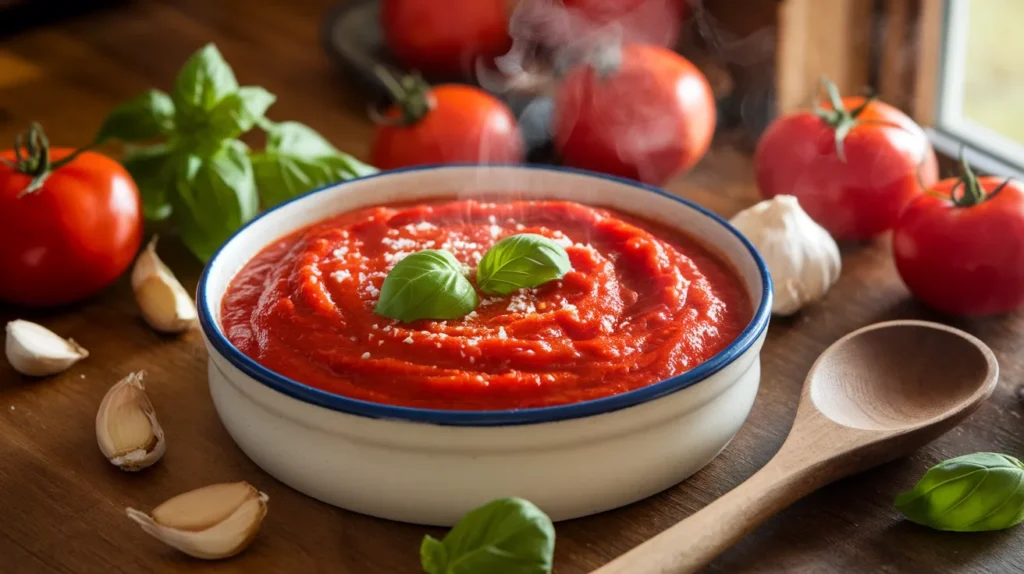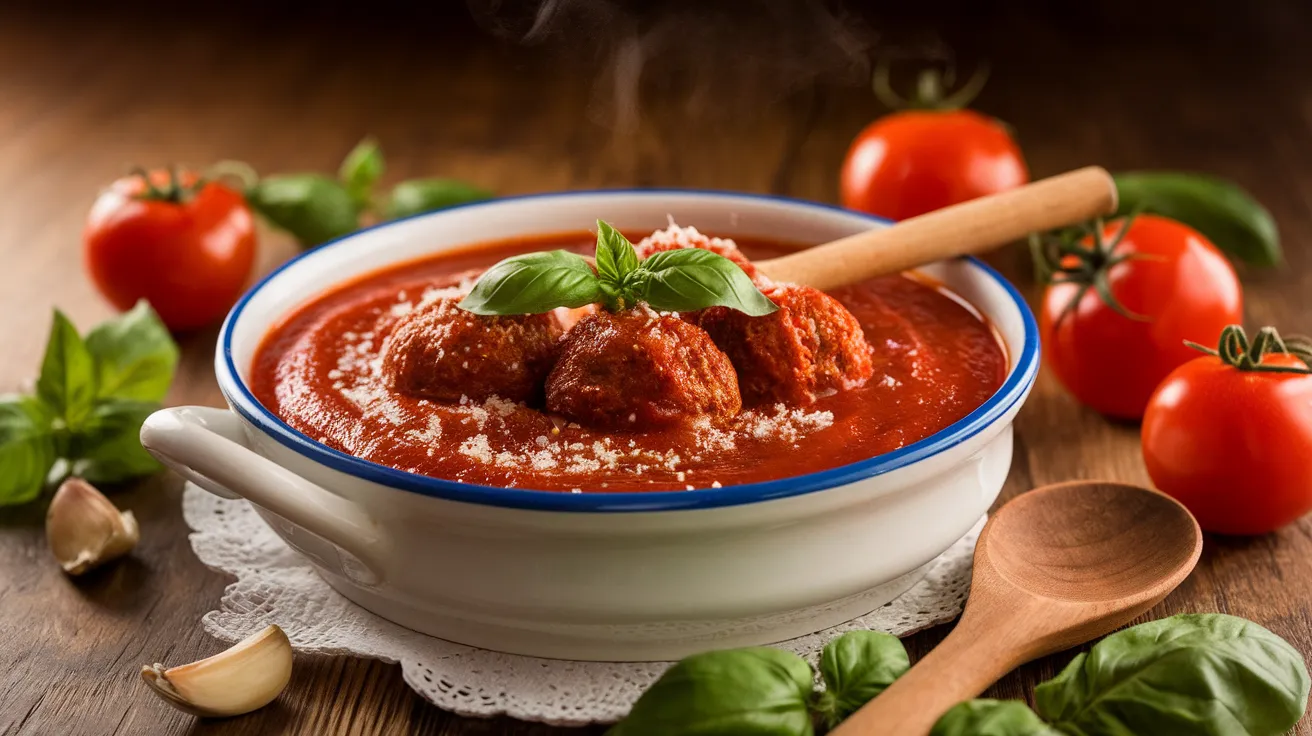This traditional sauce for Italian meatballs brings authentic Italian flavors straight to your kitchen with simple ingredients and foolproof techniques. Our homemade sauce for Italian meatballs uses time-tested methods to create a rich, aromatic sauce that perfectly complements tender meatballs, serving four people with generous portions that taste like they came from a classic Italian trattoria.
Recipe Info
SERVES: 4 | PREP: 20 MIN | COOK: 30 MIN | TOTAL: 50 MIN
Ingredients
Base Sauce
| Ingredient | Amount |
|---|---|
| Crushed San Marzano tomatoes | 28 oz can |
| Extra virgin olive oil | 3 tablespoons |
| Yellow onion, finely diced | 1 medium |
| Garlic cloves, minced | 4 cloves |
| Tomato paste | 2 tablespoons |
Seasonings & Aromatics
| Ingredient | Amount |
|---|---|
| Fresh basil leaves | 1/4 cup |
| Dried oregano | 1 teaspoon |
| Red pepper flakes | 1/4 teaspoon |
| Kosher salt | 1 teaspoon |
| Black pepper | 1/2 teaspoon |
| Granulated sugar | 1 teaspoon |
Finishing Touch
| Ingredient | Amount |
|---|---|
| Fresh parsley, chopped | 2 tablespoons |
| Parmesan cheese, grated | 1/4 cup |
Step-by-Step Instructions for Perfect Sauce for Italian Meatballs
Phase 1: Preparing Your Aromatics (10 minutes)
- Prepare your workspace first. Clear your counter space and gather all ingredients within arm’s reach. Place a small bowl near your stove for the minced garlic – this prevents burning while you work. Open the can of tomatoes and have your wooden spoon ready.
- Dice the onion properly for even cooking. Remove the papery skin from your medium yellow onion. Cut off both ends, then slice the onion in half from top to bottom. Place the flat side down on your cutting board for stability. Make horizontal cuts toward the root end (but don’t cut through it), then make vertical cuts, finally dicing across. You want pieces about 1/4-inch in size – smaller pieces cook faster and blend better into your sauce for Italian meatballs.
- Mince garlic for maximum flavor release. Remove the papery skin from 4 garlic cloves. Place the flat side of your chef’s knife over each clove and press firmly to crush it slightly – this makes peeling easier. Chop each clove roughly, then use the flat side of your knife to smear and mince the garlic into a paste-like consistency. The smaller the pieces, the more flavor they release.
- Prepare fresh herbs correctly. Gently wash your fresh basil leaves and pat them completely dry with paper towels. Wet herbs will splatter in hot oil. Stack 4-5 leaves at a time, roll them tightly like a cigar, then slice across to create thin strips called chiffonade. This prevents bruising and releases more aromatic oils.
Phase 2: Building the Flavor Foundation (8 minutes)
- Heat oil to the perfect temperature. Pour 3 tablespoons extra virgin olive oil into your heavy-bottomed saucepan over medium heat. The pan should be cold when you add the oil – this prevents hot spots. Watch for small wisps of vapor rising from the oil’s surface, which means it’s ready. The oil should shimmer but never smoke, as smoking oil tastes bitter and ruins your sauce for Italian meatballs.
- Cook onions to translucent perfection. Add your diced onion to the heated oil. You should hear a gentle sizzling – if it’s violent splattering, reduce heat immediately. Stir the onions every 30 seconds with your wooden spoon. Cook for 4-5 minutes until they become translucent (you can almost see through them) but not brown. Brown onions add sweetness, but we want clean, pure onion flavor for authentic sauce.
- Add garlic at the right moment. When onions are translucent, push them to one side of the pan and add your minced garlic to the empty space. This prevents the garlic from burning. Cook for exactly 60 seconds – you’ll smell an amazing aroma when it’s ready. Immediately stir the garlic into the onions. Burned garlic tastes harsh and bitter, ruining your entire sauce base.
- Toast tomato paste for deeper flavor. Clear a small space in your pan again and add 2 tablespoons tomato paste directly to the hot surface. Don’t stir immediately – let it cook for 30 seconds until it darkens slightly. This toasting removes the metallic taste from canned tomato paste and adds rich, concentrated tomato flavor. Now stir everything together until the paste coats all the aromatics.
Phase 3: Creating the Perfect Tomato Base (5 minutes)
- Add tomatoes with proper technique. Pour the 28 oz can of crushed tomatoes slowly into your pan – adding them too quickly causes dangerous splattering. Use your wooden spoon immediately to scrape up any browned bits stuck to the bottom of the pan. These bits are called fond and contain concentrated flavors that make your sauce for Italian meatballs taste restaurant-quality.
- Season strategically for balanced flavor. Add 1 teaspoon dried oregano, 1 teaspoon kosher salt, 1/2 teaspoon black pepper, and 1/4 teaspoon red pepper flakes. Stir thoroughly to distribute evenly. The red pepper flakes add subtle heat without making the sauce spicy – you can skip them if cooking for children.
- Balance acidity with sugar. Add 1 teaspoon granulated sugar and stir well. This isn’t to make the sauce sweet – sugar neutralizes the natural acidity in tomatoes, creating a more rounded, pleasant flavor. Without sugar, your sauce might taste sharp or sour.
- Achieve the perfect simmer. Increase heat to medium-high and stir constantly until you see the first bubbles breaking the surface. Once bubbling starts, immediately reduce heat to medium-low. You want a gentle, lazy simmer – small bubbles should break the surface every 2-3 seconds, not violent bubbling.
Phase 4: The Long Simmer for Authentic Flavor (15 minutes)
- Cover partially for proper reduction. Place your lid on the pan, then slide it slightly off-center, leaving about a 2-inch gap. This allows steam to escape while preventing excessive splattering. Total coverage makes watery sauce, while no cover causes too much reduction and potential burning.
- Monitor and stir for even cooking. Set a timer for 5-minute intervals. Every 5 minutes, give the sauce 3-4 gentle stirs, scraping the bottom to prevent sticking. The sauce should maintain its gentle simmer throughout – adjust heat as needed. If it stops bubbling, increase heat slightly; if bubbling becomes vigorous, reduce heat.
- Test for proper consistency. After 15 minutes of simmering, dip your wooden spoon into the sauce and lift it out. The sauce should coat the spoon and drip off slowly, not run off like water. If it’s still too thin, continue simmering uncovered for 3-5 more minutes. If too thick, add 2 tablespoons water and stir well.
- Conduct the final taste test. Remove the pan from heat temporarily and taste a small spoonful (be careful – it’s hot!). The sauce should taste rich and balanced, not acidic or flat. Adjust seasoning if needed: add more salt if it tastes flat, more sugar if too acidic, or more oregano for stronger herb flavor.
Phase 5: Fresh Herb Finishing Touch (2 minutes)
- Add fresh basil at the perfect moment. Return the pan to low heat and add your prepared fresh basil strips. Fresh herbs lose their bright flavor if cooked too long, so this timing is crucial for the best sauce for Italian meatballs. Stir gently for 30 seconds until the basil wilts slightly and releases its aroma.
- Final garnish and presentation. Remove the pan completely from heat. Sprinkle 2 tablespoons chopped fresh parsley over the surface – don’t stir it in completely, as the green color provides beautiful contrast. Add 1/4 cup freshly grated Parmesan cheese and give one final, gentle stir.
- Serve immediately for best results. Your sauce for Italian meatballs is now ready to serve hot. If using with cooked meatballs, add them to the sauce and simmer together for 2-3 minutes so they absorb the flavors. The sauce should be thick enough to cling to meatballs without being gluey.
Chef’s Notes for Perfect Italian Meatball Sauce
Quality Ingredients Make the Difference: San Marzano tomatoes create superior sauce for Italian meatballs because they’re naturally sweeter and less acidic than regular varieties. If unavailable, add an extra 1/2 teaspoon sugar to compensate.
Temperature Control is Everything: Gentle simmering is the secret to professional-quality sauce. High heat breaks down the tomato structure incorrectly and destroys delicate herb flavors that make authentic sauce special.
Fresh Herb Timing Matters: Adding fresh basil too early destroys its bright, peppery notes. The residual heat from your finished sauce is enough to release the herb’s essential oils without overcooking.
Overnight Improvement: This sauce for Italian meatballs actually tastes better the next day as flavors meld and deepen. Store covered in the refrigerator and reheat gently before serving.
Nutrition Per Serving
- Calories: 95
- Protein: 3g
- Carbohydrates: 14g
- Fat: 4g
- Fiber: 3g
- Sodium: 720mg
Creative Sauce for Italian Meatballs Variations
Rich Creamy Version: Stir in 1/3 cup heavy cream during the last 3 minutes of cooking for luxurious texture that coats meatballs beautifully without masking the tomato flavor.
Wine-Enhanced Sophistication: Replace 1/4 cup of tomatoes with dry red wine in step 9. The alcohol cooks off, leaving complex flavors similar to this sauce for Ikea meatballs technique.
Spicy Arrabbiata Style: Triple the red pepper flakes and add 1/4 teaspoon cayenne pepper for heat lovers who want their Italian meatball sauce with serious kick.
Garden Herb Special: Add 1 tablespoon fresh thyme and 1 teaspoon fresh rosemary with the basil. This creates herb complexity similar to sauce for jalapeño meatballs but with traditional Italian flavors.
Storage & Reheating Your Sauce
Proper Refrigeration: Cool sauce completely to room temperature before refrigerating – hot sauce creates condensation that dilutes flavor. Store in airtight containers for up to 5 days.
Freezer Storage Success: Freeze in portion-sized containers, leaving 1-inch headspace for expansion. Label with date and contents. Properly frozen sauce keeps for 4 months.
Gentle Reheating Method: Thaw overnight in refrigerator, then reheat over medium-low heat, stirring frequently. Add 2-3 tablespoons water if sauce becomes too thick during reheating.
Refreshing Herbs: Always add fresh basil and parsley after reheating to restore the bright flavors that diminish during storage and reheating.

Troubleshooting Your Italian Meatball Sauce
Sauce Tastes Too Acidic: Add sugar 1/2 teaspoon at a time, simmering 2 minutes between additions. Some tomato brands are more acidic and need extra balancing.
Consistency Too Thin: Remove lid completely and increase heat to medium. Simmer vigorously for 5-8 minutes, stirring frequently to prevent sticking, until sauce reduces to proper thickness.
Garlic Burned and Bitter: Unfortunately, burned garlic ruins the entire base. Start over with fresh oil and aromatics – there’s no way to fix this mistake.
Oil Separating from Sauce: This happens from excessive heat. Lower temperature immediately and whisk in 1 tablespoon fresh olive oil to re-emulsify the mixture.
Lacks Rich Tomato Flavor: Add 1 additional tablespoon tomato paste, cook for 2 minutes, then simmer 5 minutes longer. This intensifies the tomato base significantly.
Essential Equipment for Success
- Heavy-bottomed saucepan (3-4 quart) – prevents hot spots and scorching
- Wooden spoon – won’t scratch pan or react with acidic tomatoes
- Sharp chef’s knife – for proper vegetable preparation
- Cutting board – preferably wooden for onion work
- Can opener – for tomato cans
- Measuring cups and spoons – for accurate seasoning
- Small prep bowls – for organized ingredient staging
Organized Shopping List
Produce Section
- 1 medium yellow onion
- 1 head fresh garlic
- Fresh basil bunch (choose bright green leaves)
- Fresh parsley bunch
Canned Goods
- 28 oz can crushed San Marzano tomatoes
- Small can tomato paste (6 oz size)
Dairy Section
- Parmesan cheese block (for fresh grating)
Pantry Staples
- Extra virgin olive oil
- Dried oregano
- Red pepper flakes
- Kosher salt
- Black pepper
- Granulated sugar
Professional Success Secrets
- Mise en place preparation – Have every ingredient measured and ready before heating oil. This prevents burning aromatics while scrambling for ingredients.
- Room temperature start – Let refrigerated ingredients sit out 15 minutes before cooking for more even heat distribution and better flavor development.
- Double taste-testing – Taste once during simmering and again before serving. Flavors change as sauce reduces, requiring seasoning adjustments.
- Wooden spoon consistency test – Perfect sauce for Italian meatballs coats a wooden spoon and falls in ribbons, not drops or streams.
- Reserve pasta water trick – If serving over pasta, save 1/2 cup starchy pasta water to thin sauce if needed while maintaining proper consistency.
This authentic sauce for Italian meatballs transforms simple ingredients into restaurant-quality results using traditional techniques that guarantee perfect flavor balance every single time.




